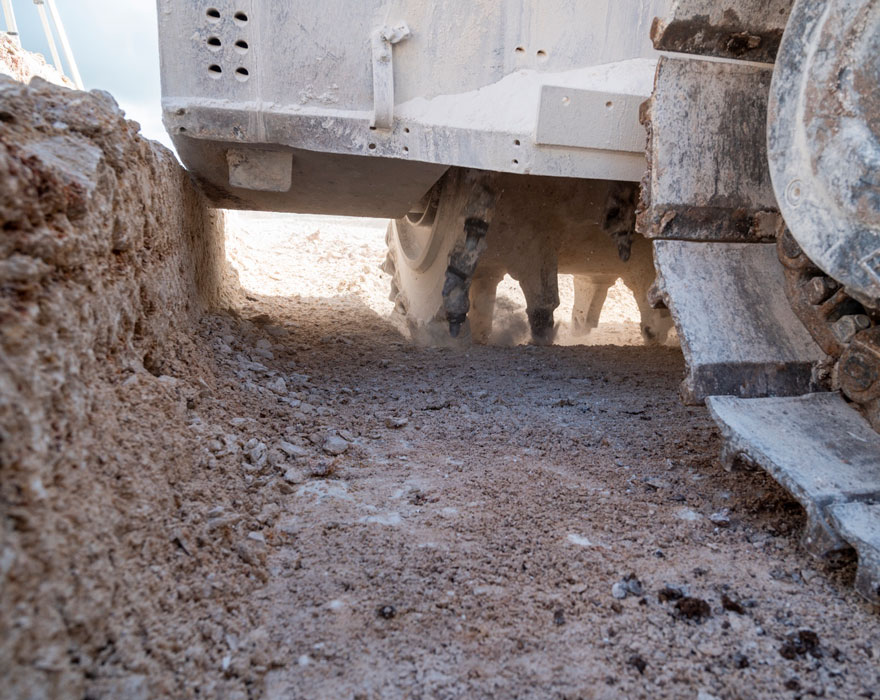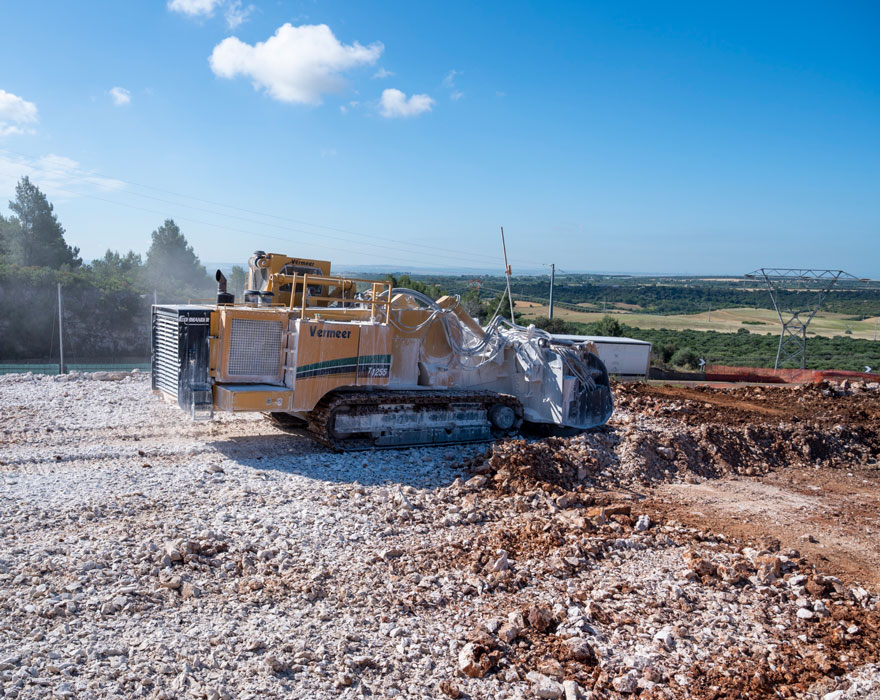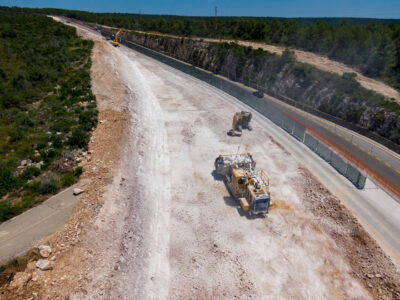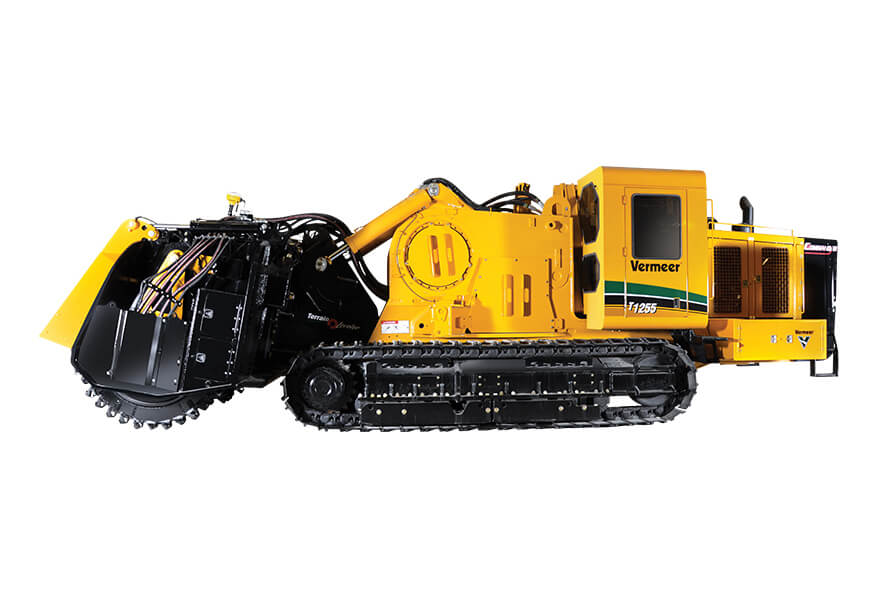In the heel of Italy, agricultural produce is increasingly on the move to remote processing plants and far-flung markets. The region’s prosperity depends on an efficient transport infrastructure.
And the Vermeer T1255III surface miner is playing a key part in making that possible.
Many of the undivided highways that have long served as the region’s road network — single lanes in each direction — are making way for more efficient divided highways. That includes a section of the SS172 at Martina Franca, near Taranto in the Apulia region of southeast Italy.
In 2021, engineers used the Vermeer T1255III to level and widen the roadway there — and create more economic opportunity in the region.
“We’re talking about the excavation of hard rock — no small undertaking,” said Pierpaolo Romita, an engineer at ANAS SpA, the government-owned company responsible for highway construction and management.
But engineers had another issue to consider as well.
“Excavated rock is normally reused as road substrate on the same site,” Romita said during the 2021 roadway construction. “However, taking it away for crushing and then bringing it back is very time-consuming and costly. So, we wanted a solution that would allow us to keep everything onsite. A mobile crusher wasn’t an option because the new roadbed was being created right alongside the existing highway, which was still in use.”
Project contractors Bulfaro S.p.A and Murano Srl suggested a surface miner as the way to go. They landed on the T1255III.
“It’s worked out really well,” Romita said.
Vermeer surface miner: ‘No problem’ in tough conditions
Bulfaro S.p.A’s Giuseppe Bulfaro knew years ago what kind of machine he wanted for the Apulia roadway project.
“We first came across Vermeer about 10 years ago when excavating close to Taranto, and we were impressed by the capabilities of their machinery,” Bulfaro said. “So, when it came to tendering for this contract, we got in contact again to find out whether one of their … surface miners might be suitable.”
Things moved quickly from there.
“From research and site visits, it soon became clear that a T1255III would considerably reduce the number of processing steps, while keeping the quality high,” said Franco Murano, who heads Bulfaro’s consortium partner, Murano Srl. “We looked carefully at the various machines on the market, and the Vermeer machine was the only one capable of dealing with the large amount of rocky material that had to be excavated, delivering the required productivity and meeting our precision requirements.”
This Vermeer surface miner was made for the type of work seen at the 2021 Apulia roadway project.
It’s a crawler-tracked machine with a toothed drum at the rear. As the machine moves forward, the drum rotates on its axis, which is at a right angle to the direction of travel. The drum is lowered onto the surface behind the advancing machine so its teeth bite into the rock and break it up. Instead of drawing on the machine’s tractive power, the drum on this Vermeer SEM has its own direct-drive motor, optimizing control. In combination with a top-down cutting system where the teeth strike the surface from above, the setup delivers ideal rock-breaking performance. That translates into the capability to excavate cuttings with high-wall grades of up to 80 degrees.

“One of the big attractions of the T1255III was its high capacity,” Bulfaro surveyor Fabio Guarino said in 2021. “Under favorable circumstances, it can cut 700 cubic meters to 900 cubic meters of rock per day [in these conditions]. The need to repeatedly pause the work and relocate the unit as the work progresses means that those figures aren’t possible on this particular site.”
“We’re definitely moving faster with the T1255III than we could have done otherwise. There are some very hard, compact bedrock sectors at this site, but the T1255III has handled them, no problem.”
Vermeer surface miner helps shape a modern future that respects a region’s heritage
Vermeer Italia has been closely involved with the project from an early stage.
And the importance of that was not lost on Bulfaro engineer Ernesto Scarnati.
“At the outset, we did have concerns about the hardness of the rock,” he said in 2021. “But we had excellent support from the technical staff at Vermeer Italia. They helped us evaluate the project and suggested ways of optimizing the rig for the conditions.”
Vermeer onsite technical support was crucial in other ways too.
Winning the Martina Franca project contract meant committing to a strict timeline laid down by ANAS. Any departure from the schedule would have significant contractual implications. Bulfaro-Murano therefore needed to be sure not only that the excavation rate would be fast enough, but also that there would be no undue breakdown or maintenance delays, that consumables would be readily available and that the consortium’s machine operators wouldn’t have problems adapting to the T1255III.

For Franco Murano, a clinching factor was seeing that the T1255III control systems are as intuitive as they are sophisticated.
Vermeer SmartTEC control software presents all critical performance variables on an integrated display. The control panel is also positioned so that the operator, seated in an elevated cab with all-round visibility, can view the screen without changing position.
“The technical assistance and onsite support available from Vermeer have been very important,” he said.
With deep roots in the community and a keen awareness of the cultural and ecological value of the ancient landscape in which they are working, the two companies placed considerable emphasis on minimizing any adverse effects the project might have.
“Using the (T1255III) has enabled us to reduce the environmental impact,” Giuseppe Bulfaro said. “Without it, we would have had to use more destructive excavation techniques then repeatedly transport and process the excavated material offsite. Because there’s no need for blasting, hammering, road transport or crushing, the project has a smaller carbon footprint and is causing less disturbance to local people.
“Thanks to the Vermeer T1255III, we’re able to create the modern infrastructure Apulia needs while respecting the region’s precious and unique heritage and landscape.”
For more information on the T1255III or other surface mining equipment, reach out to your local Vermeer dealer.
This article contains third-party observations, advice or experiences that do not necessarily reflect the opinions of Vermeer Corporation, its affiliates or its dealers. Testimonials and/or endorsements by customers in specific circumstances may not be representative of normal circumstances experienced by all customers.
Vermeer Corporation reserves the right to make changes in engineering, design and specifications; add improvements; or discontinue manufacturing at any time without notice or obligation. Equipment shown is for illustrative purposes only and may display optional accessories or components specific to their global region.
Please contact your local Vermeer dealer for more information on machine specifications. Vermeer, the Vermeer logo, Equipped to Do More and Terrain Leveler are trademarks of Vermeer Manufacturing Company in the U.S. and/or other countries.
© 2024 Vermeer Corporation. All Rights Reserved.

